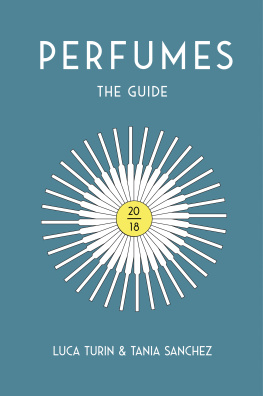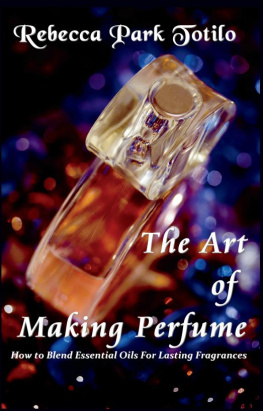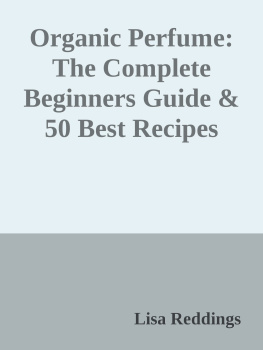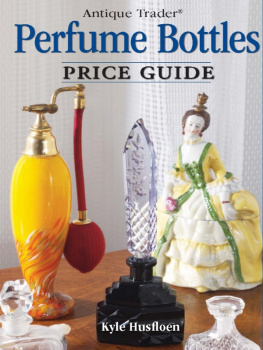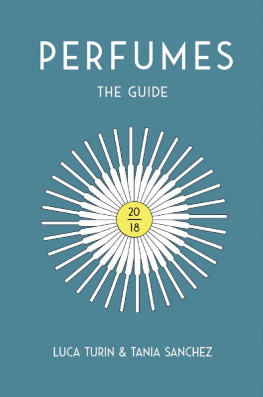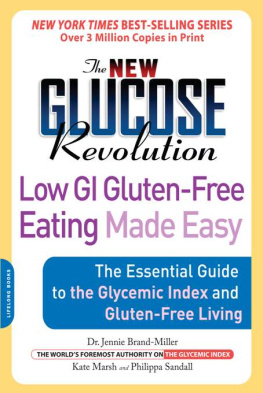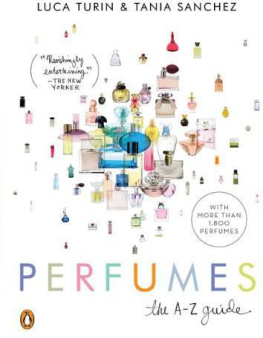Sanchez Tania - Perfumes: the guide 2018
Here you can read online Sanchez Tania - Perfumes: the guide 2018 full text of the book (entire story) in english for free. Download pdf and epub, get meaning, cover and reviews about this ebook. City: Tallinn;Estonia, year: 2018, publisher: Perfüümista OÜ, genre: Art. Description of the work, (preface) as well as reviews are available. Best literature library LitArk.com created for fans of good reading and offers a wide selection of genres:
Romance novel
Science fiction
Adventure
Detective
Science
History
Home and family
Prose
Art
Politics
Computer
Non-fiction
Religion
Business
Children
Humor
Choose a favorite category and find really read worthwhile books. Enjoy immersion in the world of imagination, feel the emotions of the characters or learn something new for yourself, make an fascinating discovery.
- Book:Perfumes: the guide 2018
- Author:
- Publisher:Perfüümista OÜ
- Genre:
- Year:2018
- City:Tallinn;Estonia
- Rating:5 / 5
- Favourites:Add to favourites
- Your mark:
- 100
- 1
- 2
- 3
- 4
- 5
Perfumes: the guide 2018: summary, description and annotation
We offer to read an annotation, description, summary or preface (depends on what the author of the book "Perfumes: the guide 2018" wrote himself). If you haven't found the necessary information about the book — write in the comments, we will try to find it.
Perfumes: the guide 2018 — read online for free the complete book (whole text) full work
Below is the text of the book, divided by pages. System saving the place of the last page read, allows you to conveniently read the book "Perfumes: the guide 2018" online for free, without having to search again every time where you left off. Put a bookmark, and you can go to the page where you finished reading at any time.
Font size:
Interval:
Bookmark:

Perfumes
the Guide
2018
Luca Turin
& Tania Sanchez
Published by Perfmista
Tallinn, Eesti
Copyright Luca Turin and Tania Sanchez, 2018
All rights reserved. No part of this publication may be reproduced, distributed, or transmitted in any form or by any means, including photocopying, recording, or other electronic or mechanical methods, without the prior written permission of the publisher, except in the case of brief quotations embodied in critical reviews and certain other noncommercial uses permitted by copyright law. For permission requests, please contact us at perfuumista@gmail.com or via the website www.perfumestheguide.com.
First printed in 2018
ISBN 978-9949-88-553-4
Some reviews previously appeared in slightly different form in Style (now Vogue) Arabia.
For the kids
Contents
Acknowledgments
Thanks to all the perfumers who sent samples of their work. Our special thanks to Michael Edwards, whose Fragrances of the World database has been an indispensable help and a marvel of accuracy and comprehensiveness. We also thank Franco Wright of Luckyscent, Arielle Shoshana, Christie Shen of Xiujuexi (), the organizers of Esxence, Will Inrig, Katie Puckrik, user Pluran at Basenotes, the Institute for Art & Olfaction, and Caterina Minthe at Vogue (formerly Style) Arabia for support and assistance. Thank you to the kind staff of Attica department stores and Hondos Center in various locations in Athens, Greece, for their indulgence of our suspicious loitering. And thanks to Micah Hahn for his ideas and assistance designing the cover.
Perfumes
the Guide
2018
A bout This Guide
We review critically over 1,200 fragrances in this guide. Though that may seem impressive, bear in mind that between 2009 and 2017, Michael Edwardss Fragrances of the World database added 16,664 new perfumes. Even ten years ago, it was impossible to consider reviewing all perfumes available. Now its laughable.
So what have we done instead? In the 2008/2009 guide we addressed, bottle by bottle, the big picture of the world of fragrance, from its origins to the present day. This 2018 guide begins a slightly different project, an ongoing sampling of the current state of perfumery, which happens to be in the middle of drastic change. The good news is that there is a lot of brilliant stuff out there. The bad news is that theres even more cheaply put together, derivative, or just plain awful filler than before (and some of it audaciously expensive).
These reviews are not objective assessments deriving from scientific analysis. They, like all criticism, are the work of informed subjectivity. What makes a good perfume? I explain the idea of the art of perfumery at length in the previous guide, so I wont repeat myself, but to sum up, we are looking for beauty (does it smell good?), ideas (does it smell interesting?), novelty (have we smelled it before?), and skill (has it been worked out technically?).
Naturally, the first criterion, whether the thing smells good, is the one most open to argument. Of course there are fragrances rated highly in the book that will strike some people as noxious, others as the treasure at the end of a lifetime of search. Having done it ourselves, though, we can attest that anyone who seeks out the fragrances that have earned our higher ratings will be rewarded by experiencing some of the best of the current art of the perfumer. TS
Ten Years Later
Jointly and severally, Luca and I have now smelled several thousand perfumes and discussed them over half a dozen different kitchen tables in at least as many different countries. Our combined collection, even after paring down, fills three extended-height IKEA Billy glass-fronted cabinets in the basement. And I continue to feel that this task of ours, of addressing the artistry of perfume and insisting upon the notion that some of these things are good, some bad, and some great, needs doing well, now possibly more than before.
When Viking Penguin (and Profile in the UK) published the first edition of Perfumes: The Guide in 2008, to our surprise, our celebration of the era of classic perfumery became something of a eulogy, since many of the best creations of the past had been discontinued or defaced by budgets, allergen restrictions, the deaths of firms, changing tastes and supply chains. It was the last time many of the great perfumes of the twentieth century would be for sale in anything resembling original spec. We swore, after we updated the book in paperback and then assessed the interim damage to the masterpieces in The Little Book of Perfumes: 100 Classics , that we did not want to spend the rest of our years raging as we typed out ever more fragrance obituaries. We moved on. Yet into the ecological vacuum left by all these extinctions, a horde of niche and independent perfumers emerged, a sort of Cambrian explosion of new companies, new genres, new ideas. After years of sometimes avoiding even wearing the stuff, we began tentatively to wander onto the fragrance floors of department stores, then into small independent shops, finding that we, world experts in perfume, no longer knew half of what was going on. We started spraying things. It was fun. We knew we had to revive the guide. Perfume is dead. Long live Perfume!
First, place aux jeunes: make room for the young, as my trilingual stepson used to put it as he squeezed in on the couch. The last ten or fifteen years have seen new faces everywhere, and not from the same old place, i.e. France, i.e. Grasse. That model had already begun shifting when we wrote the first book, with self-taught Swiss perfumer Andy Tauers LAir du Dsert Marocain (which Luca wore at our city hall wedding the week we finished the manuscript) earning a five-star recommendation. Sure enough, a substantial number of the perfumers whose work we review in this new guide are free agents, some with professional training and others pure auto-didacts. And an ever growing number of them are women and openly gay men, a welcome change in a traditionally macho industry once fond of, when not hiding the existence of perfumers, putting forth a male one to ramble on in Gallic mode about how Perfume Is About the Beauty of the Woman. While its true that few independent perfumers can enjoy the benefits of the technicians, weighing robots, analyses, and giant palette of thousands of materials, they also tend to be less constrained by pinched budgets, focus groups, and rushed schedules. The brands are also increasingly independent, new and small, generally unaffiliated with any multinational conglomerate (though clever Este Lauder went on a buying spree and snatched up Frdric Malle and Kilian).
As this indie fragrance revolution unfolds, the future centrality of France seems far from assured. And Luca and I both hope this means eventually we will stop seeing French as the international language of perfume, in particular, Bad French, and in particular particular, Bad French Puns. If you are based in Brooklyn, you have no excuse for naming your fragrance Nuit Noire des Fleurs Blanches Pour Femme or whatever you pieced together from your high school textbook plus Google Translate. May I suggest Esperanto?
Perfume education has also decentralized, with a global boom in smaller new competitors to Frances main independent perfumery schools (ISIPCA, Ecole Suprieure du Parfum, Cinquime Sens, and the Grasse Institute of Perfumery). While some of this perfume education is surely a rip-offI give side-eye to a former marketing professional offering perfumery classes on her website for hundreds of dollars a session, when it would be generous to describe her own fragrances as pedestrianit cannot all be, since some of the perfumes we reviewed, composed by persons who never set foot in a fragrance company, are good and great. The Institute for Art & Olfaction promotes independent perfumery via its much anticipated annual IAO awards, of which Luca has been a sometime judge. In previous years, the awards split into separate categories for independent brands, which contracted the services of outside perfumers, and artisans, who compose their own fragrances, to give the amateurs a chance. In the most recent round, as Luca let me smell the blind judging samples, we were startled: the artisans had surpassed the pros. Now it gets interesting.
Font size:
Interval:
Bookmark:
Similar books «Perfumes: the guide 2018»
Look at similar books to Perfumes: the guide 2018. We have selected literature similar in name and meaning in the hope of providing readers with more options to find new, interesting, not yet read works.
Discussion, reviews of the book Perfumes: the guide 2018 and just readers' own opinions. Leave your comments, write what you think about the work, its meaning or the main characters. Specify what exactly you liked and what you didn't like, and why you think so.

